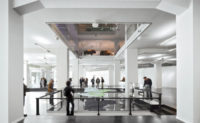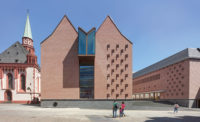Essen, Germany
Once vilified for pollution and noise, the mines and factories of the Ruhr district (Ruhrgebiet), Germany’s former coal and steel belt, have become proud symbols of the region’s industrial past. One inactive coal mine, the Zeche Zollverein in Essen, is now a UNESCO World Heritage site and houses a cultural center, following a master plan by Rem Koolhaas and his firm, OMA. With architects Heinrich Böll and Hans Krabel, Koolhaas also repurposed the coal mine’s Kohlenwäsche (coal-washing plant), transforming it into the Stiftung Ruhr Museum in 2006. Leaving the plant’s machinery intact, the architects’ bold interventions—including an escalator that transports visitors to the entrance, 80 feet above ground, where they then move downward through the plant, following the path coal once traveled—marked a new chapter in the building’s history.
According to Denkinger, the design had to organize the disparate artifacts and the cell structure into a narrative—because “exhibition designs are like short stories”—linking the Ruhr’s distant past with its post-industrial present. At the same time, it had to protect the building’s historic structure with a temporary architecture that could only be placed in position and clamped or hung from existing ceiling tracks.
Denkinger inserted a field of modular display units, measuring about 3 feet high and ranging from 18 to 25 inches wide, between the cells. Made out of MDF panels clad in steel sheets with a charcoal-gray powder coating, these units served as a base for both freestanding artifacts and others protected by vitrines made of safety glass.
Challenged by a floor that slopes from the entry to the rear, the architect inserted adjustable supports under the units to maintain an even datum line. Then he arranged the units to define a path around the gallery, linking the exhibit’s five sections—everyday life, conflict, cultural development, beliefs, and the modern interpretation of this period. Along this path, ceramic vessels and weapons yielded to reliquaries, elaborate gravestones, and finally present-day paintings and sculptures that depict this history. These encircled a central arrangement of manuscripts—cloister inventories, musical notation, and illustrated prayer books—which occupied 24 vitrines set upon 10-inch-high bases. The path was straight and wide at the start, becoming narrower and more irregular at the end. There one felt disoriented, as if the past were easier to comprehend than the present.
Such rare and fragile objects necessitated extremely low light levels. To assist in orientation, Denkinger created a “lattice of light,” a series of perforated platforms underlit by LEDs, that marked the exhibition’s transitional zones—the gallery entrance, the introduction of the path, and the point where it segued to the manuscripts. Halogen luminaires on ceiling tracks accented exhibits. Integrated LEDs within both raised and recessed vitrines illuminated the manuscripts and other sensitive artifacts. Top-lit chain-link curtains glowed softly in front of the rear wall to mute the exit signage and signaled the beginning of the modern section.
As visitors moved through the museum’s dusky interior, forms emerged from the darkness as luminous beams showcased gold-encrusted swords, ivory reliquaries, or pottery shards. Complementing its haptic appeal, the architecture of Werdendes Ruhrgebiet invited interpretation: the placement of the manuscripts at the center of the gallery established written knowledge at the heart of this region’s culture, while elaborate gold crucifixes placed in high vitrines loomed over the section about beliefs, a nod to Christianity’s rise and endurance. And, as it hugged the base of the coal-washing cells, the display proposed that the region’s early development laid the basis for its industrial heyday. “It was difficult to show hierarchies in this exhibition,” reflects Denkinger, because “all stories are equal.”
PeopleClient: Stiftung Ruhr Museum, Fritz-Schupp-Allee 15, D-45141 Essen; www. ruhrmuseum.de Owner: Stiftung Ruhr Museum
Architect: Interior designer: Bernhard Denkinger (registered architect)
Consultant(s):
General contractor:
Photographer(s): Size: 10,225 square feet Project cost: $560,000 Construction cost: $168,000 Completion Date: March 2015 |
Products
Glazing
Interior finishes
Special interior finishes unique to this project: Curtains made of industrial chains: Heinrich Schäfers, Schmiede- und Bauschlosserei GmbH. Bonifaciusring 19, D-45309 Essen, info@schaefers.ruhr
Lighting Downlights: Existing Spots of ERCO were used, they can be dimmed individually |


















Post a comment to this article
Report Abusive Comment